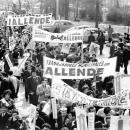When I first showed up in Deutschland, camping on the Rhine
The first town that I went to was also the first sign
Of the kind of self-reflection that had gone on around here
Indications everywhere, so shiny and so clear
Look down at the sidewalk where a little light is shown
When you stumble upon a stumbling stone
Stumble upon a stumbling stone
What did this place once look like, who lived on this block
It can't be recreated but you can partially take stock
Look down at the sidewalk for a little bronze square
Read the words engraved upon it that says who was living there
Before they were taken away to the dark unknown
When you stumble upon a stumbling stone
Stumble upon a stumbling stone
Little squares all over, you'll find them all around
Not much information on them, and they don't make a sound
But if your imagination is anything like mine
Then all you need to trigger it is one lone Stolpersteine
Take a moment to remember as you look down from your phone
When you stumble upon a stumbling stone
Stumble upon a stumbling stone
There are six little squares here – one for each member
Of one family that was taken one morning in December
The youngest child was 2, the eldest one was 10
Within a year each one of them had died at Sachsenhausen
Their bodies burnt to ashes – flesh and blood and bone
When you stumble upon a stumbling stone
Stumble upon a stumbling stone
And every time I see them I wish I would see more
Embedded in the sidewalks on so many other shores
Just one stone to remember each one who met their fate
At all the slave plantations, in all the torture states
But for some it's safer to just leave the dead alone
When you stumble upon a stumbling stone
Stumble upon a stumbling stone
Stumble upon a stumbling stone
The first town that I went to was also the first sign
Of the kind of self-reflection that had gone on around here
Indications everywhere, so shiny and so clear
Look down at the sidewalk where a little light is shown
When you stumble upon a stumbling stone
Stumble upon a stumbling stone
What did this place once look like, who lived on this block
It can't be recreated but you can partially take stock
Look down at the sidewalk for a little bronze square
Read the words engraved upon it that says who was living there
Before they were taken away to the dark unknown
When you stumble upon a stumbling stone
Stumble upon a stumbling stone
Little squares all over, you'll find them all around
Not much information on them, and they don't make a sound
But if your imagination is anything like mine
Then all you need to trigger it is one lone Stolpersteine
Take a moment to remember as you look down from your phone
When you stumble upon a stumbling stone
Stumble upon a stumbling stone
There are six little squares here – one for each member
Of one family that was taken one morning in December
The youngest child was 2, the eldest one was 10
Within a year each one of them had died at Sachsenhausen
Their bodies burnt to ashes – flesh and blood and bone
When you stumble upon a stumbling stone
Stumble upon a stumbling stone
And every time I see them I wish I would see more
Embedded in the sidewalks on so many other shores
Just one stone to remember each one who met their fate
At all the slave plantations, in all the torture states
But for some it's safer to just leave the dead alone
When you stumble upon a stumbling stone
Stumble upon a stumbling stone
Stumble upon a stumbling stone
Contributed by Dq82 - 2018/12/27 - 15:57
×
![]()
Note for non-Italian users: Sorry, though the interface of this website is translated into English, most commentaries and biographies are in Italian and/or in other languages like French, German, Spanish, Russian etc.







1939
Stumbling stones. A German artist named Gunter Demnig started putting little bronze squares in the sidewalks of German cities in 1992. Now there are thousands of them in several different countries in Europe. They are placed in front of the homes and workshops from which people were taken to be sent to concentration camps, primarily. It's a powerful form of art, turning much of Germany into a permanent exhibit, a constant reminder of what has been, and what must never be.
Pietre d'inciampo. Un artista tedesco Gunter Demnig ha iniziato a posizionare delle piccole lapidi di bronzo sui marciapiedi delle città tedesche nel 1992. Adesso ce ne sono migliaia sparse in diverse nazioni europee, posizionate di fronte alle case o alle botteghe, da cui le perosne sono state prelevate per essere portate nei campi di sterminio. E' una forma d'arte piena di forza, che trasforma la Germania in una mostra permanente, un continuo ricordo di quello che è stato e non dovrà mai più ripetersi.
E visto che qualcuno ha paura di questo ricordo, a Roma ha pensato bene di farne sparire una ventina, in pieno centro.